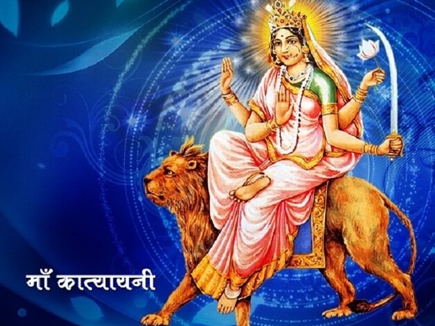one of the most ferocious and menacing avatars of Goddess Durga is invoked on the sixth day of Navaratri

Abhinit Kumar
The sixth day of Navratri is dedicated to the worship of Maa Katyayani and signifies cheerfulness and joy. Believed to be the destroyer of all evil, she is seen as a warrior goddess who was able to bring peace to the world. Maa Katyayani is one of the fiercest forms of Goddess Durga. She is also known as Mahishasurmardini (Killer of Mahishasura), as she was able to defeat and kill the evil demon Mahishasura.
History and Origin
It is told that long ago there was a sage by the name of Katyayana. He was a huge devotee of Goddess Shakti and spent days and nights in prayer. Sage Katyayana always wished for Goddess Shakti be born as his daughter.
During this period, an evil demon named Mahishasura was creating great trouble for the Gods. As the days went by, he gained more power and the Gods were increasingly worried about him. They prayed to Goddess Shakti and asked her to save them from the wrath of Mahishasura.
Goddess Shakti decided to take birth on Earth and end the reign of Mahishasura. She granted the wish of Sage Katyayana and was born on Earth as his daughter. She grew up to be a strong, beautiful fighter and came to be known as Katyayani, the daughter of Katyayana.
One day, two messengers of Mahishasura – Chandha and Mundha – saw Katyayani and were mesmerized by her beauty. They went back to their master and told him all about Katyayani Upon hearing this, Mahishasura got very happy and immediately asked another of his messenger – Dundubhi – to go and talk to Katyayani.
Dundubhi met Katyayani and told her all about Mahishasura. He told her about his greatness and boasted about how Mahishasura was the now the ruler of all three worlds. He told Katyayani that she should marry Mahishasura as they would make a great couple.
Katyayani smiled and told Dundubhi that according to her family tradition, Mahishasura must first defeat her in battle. Only then can they both get married. Dundubhi went back to Mahishaura and told him about this challenge. Mahishasura agreed and soon the preparations began.
A fierce battle took place between Katyayani and Mahishasura. She managed to defeat his demon soldiers and even killed most of them. When Katyayani and Mahishasura came face to face, he transformed himself into a buffalo. This proved to be a real challenge for Katyayani as she struggled to fight him. However, Katyayani tricked Mahishasura and climbed onto his back. He was surprised by this move and tried very hard to shake her off, but failed. Katyayani then placed her foot on the back of Mahishasura’s neck, pierced him with her Trishul (trident) and cut his head off.
Goddess of the Sixth Day of Navratri
Since, Maa Katyayani defeated and killed Mahishasura, she is also known as Mahishasurmardini. In many parts of India, unmarried girls often observe fasts and pray to Maa Katyayani in order to get a loving and caring husband. She is an incarnation of Goddess Durga and is depicted as having four hands. She holds a lotus in two hands, a sword in one and blesses her devotees with the fourth hand. It is believed that she protects her devotees from all kinds of evil and blesses them with happiness and joy. As Navratri progresses through its nine nights, the sixth day takes a distinctive turn as devotees honor Goddess Katyayani, who embodies the essence of a resolute warrior. Her name is a tribute to Sage Katyayana, her dedicated devotee known for his intense penance and devotion. The form of Katyayani symbolises unyielding courage and valor.
A warrior’s grace: Depicting Katyayani
In her depictions, simplicity reigns. With four arms wielding an array of formidable weapons and symbols of power, she sits gracefully atop a lion. Her aura resonates with courage and fearlessness, reminding all of the power found in unwavering determination.
Simplicity in devotion: rituals
The sixth day of Navratri commences with uncomplicated rituals – an early rise, a cleansing bath, and the donning of fresh, vibrant attire. Devotees present their offerings with heartfelt sincerity, which include prayers, fragrant incense, fragrant blooms, and the sweetness of honey.
Seeking courage in chants
Chanting mantras dedicated to Goddess Katyayani is an integral part of her worship. Devotees pour their hearts into these mantras, seeking her blessings and yearning for the infusion of courage that she represents. Her divine presence is believed to bestow courage on those who beseech her.
Temples of resilience
Temples devoted to Goddess Katyayani are a source of spiritual strength and inspiration on this special day. Pilgrims gather with a humble desire to offer their heartfelt prayers and invoke the warrior-like blessings of the goddess. In these sacred precincts, special pujas and rituals are conducted to honor her.
A symbol of unyielding determination
Katyayani’s embodiment of courage and valor resonates deeply with Indian culture. She symbolizes an unshakeable spirit, inspiring individuals to confront life’s trials with unwavering determination.
On the sixth day of Navratri, as devotees worship Goddess Katyayani, they seek her blessings for unwavering courage and indomitable valor.
She stands as a symbol of resolute determination, reminding individuals to approach life’s challenges with unwavering fortitude. In their devotion to Goddess Katyayani, they implore for strength to conquer obstacles and the resolve to emerge victorious in life’s battles.
Worshipping Maa Katyayani is a call for inner strength, an invocation for the bravery to face life’s adversities head-on. She is adored for her warrior-like attributes and her unwavering commitment to safeguard her devotees.
Date and shubh muhurat
This year, the sixth day of Chaitra Navratri falls on Sunday, April 14. According to Drik Panchang, the Brahma Muhurta on this day begins at 4:40 am and ends at 5:26 am. The Abhijit Muhurat will start at 11:58 am and end at 12:47 pm, and Vijaya Muhurta will last from 2:25 pm and end at 5:15 pm. Additionally, the Ravi Yoga will be observed from 6:13 am on April 14 to 1:35 am on April 15.
Significance
Maa Katyayani is associated with the planet Brihaspati and embodies qualities of intelligence and peace. Her divine blessings are believed to cleanse devotees of their sins, dispel negative energies, and overcome obstacles. During Navratri, unmarried girls observe fasts on the day dedicated to worshipping Maa Katyayani, seeking her blessings to find a suitable spouse of their choice.
Colour
Worshipping the goddess Katyayani while dressed in orange on Sunday is believed to give the worshipper qualities of warmth and exuberance. The colour orange is associated with positive energy and promotes cheerfulness and vitality in the individual.
Maa Katyayani Bhog
On the sixth day of Chaitra Navratri, devotees honour Goddess Katyayani, the sixth manifestation of Maa Durga, by offering honey as a special bhog as part of their worship rituals.
Puja Vidhi and Samagri
On the sixth day of Navratri, devotees are encouraged to rise early, bathe, and attire themselves in new garments. They should meticulously clean the puja area and adorn the idol of Maa Katyayani with fresh flowers. While reciting mantras and offering prayers, devotees are advised to hold lotus flowers in their hands and present honey as prasad and bhog to the goddess, seeking her divine blessings.
Puja Mantra, Prathana, Stuti and Kavacha
1. Om Devi Katyayanyai Namah॥
2. Chandrahasojjvalakara Shardulavaravahana।
3. Katyayani Shubham Dadyad Devi Danavaghatini॥
Ya Devi Sarvabhuteshu Ma Katyayani Rupena Samsthita।
4. Namastasyai Namastasyai Namastasyai Namo Namah॥
Katyayanaumukha Patu Kam Swahaswarupini।
Lalate Vijaya Patu Malini Nitya Sundari॥
Kalyani Hridayam Patu Jaya Bhagamalini॥


